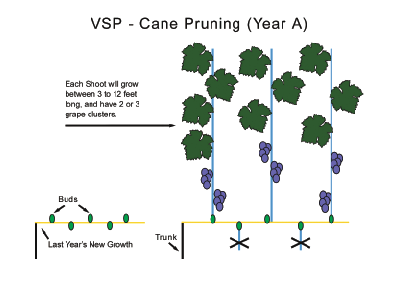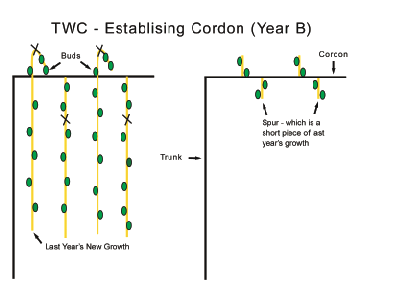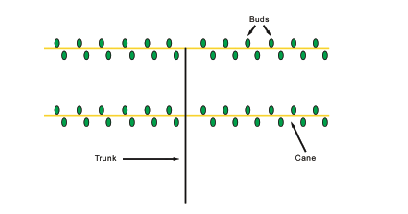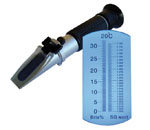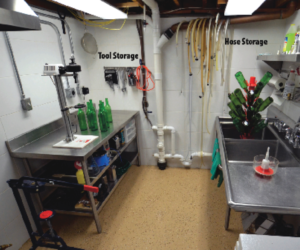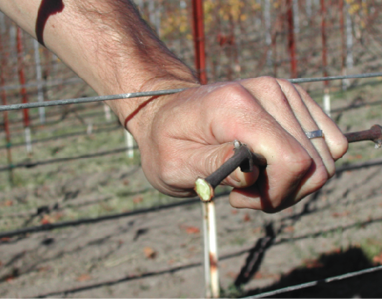 Pruning is the removal of portions of the vine. Training is the arrangement of the vine parts both immediately after pruning and as the vine grows. The trellis is the physical structure upon which the vine grows. All three of the above elements are used to optimize the vine’s performance. The goal is to balance the photosynthesis capability of the vine with the amount of fruit produced by the vine. A vine that has such balance will optimize its production capacity. It is not enough to ensure that we have enough solar panels (leaves) producing energy to bring the fruit to maturity. We must also ensure that the leaves are arranged such that they permit sufficient fruit exposure. Exposing the fruit facilitates three very important benefits:
Pruning is the removal of portions of the vine. Training is the arrangement of the vine parts both immediately after pruning and as the vine grows. The trellis is the physical structure upon which the vine grows. All three of the above elements are used to optimize the vine’s performance. The goal is to balance the photosynthesis capability of the vine with the amount of fruit produced by the vine. A vine that has such balance will optimize its production capacity. It is not enough to ensure that we have enough solar panels (leaves) producing energy to bring the fruit to maturity. We must also ensure that the leaves are arranged such that they permit sufficient fruit exposure. Exposing the fruit facilitates three very important benefits:
a) Sun exposure to help ripen the grapes
b) Wind exposure to dry the clusters after rain or dew
c) Pesticides exposure to protect the clusters from insect and disease threats
To help make this discussion easier to understand, let’s begin with a review of a relevant pruning vocabulary:
Trunk – Permanent, above ground stem of the vine.
Cane – A mature shoot after leaf fall (last year’s wood).
Spur – A cane (last year’s wood) pruned back to one, two, or three buds.
Cordon – Wood that is two or more years old and trained along a wire. A cordon will have spurs protruding from it.
Shoot – New green growth with leaves, tendrils, and often flower clusters, developing from a bud of a cane or spur.
Lateral – Branch of a shoot.
Sucker – A shoot growing from old wood, often the trunk base, rather than from shoots or canes.
Tendril – A twisting threadlike part of a shoot that provides vine support by wrapping around nearby objects.
Node – The location of a compound bud along a cane or spur, and occasionally along the trunk or cordon.
Compound bud – Contains a primary, a secondary, and a tertiary bud.
Primary bud – Is the first bud to develop a shoot, which will usually produce approximately two clusters of grapes. If a shoot that was developed from a primary bud is damaged by frost or by other means, a secondary bud can produce a replacement shoot.
Secondary bud – As noted above, the shoot from a secondary bud can replace a damaged shoot from the primary bud. In a vigorous vine, the secondary bud may produce a shoot even though the primary shoot is intact and healthy. A shoot from a secondary bud will usually produce approximately one cluster of grapes.
Tertiary bud – A shoot from a tertiary bud will usually not bear any fruit, but it will help provide energy to the vine for survival.
Pruning is both an art and a science. Pruning is an attempt to coordinate between nature and nurture. The vine pruner will determine the number of buds that will remain, and the arrangement of those buds on the trellis system. I consider this an art because the pruner has to look at each vine’s set of unique bud selection options, and make decisions based on those unique options. Some buds will be located in useful locations, some will not. Buds that have had good sun exposure in the previous growing season will usually be the most fruitful. Some buds will be damaged over the dormant period and some will not. Retaining too many buds will create overcrowding of the canopy and stress the vine because of over cropping. Retaining too few buds will not produce the yield that the vine is capable of. Mother Nature will impact the buds that were left on the vine by the pruner. Sun, rain, frost, wind, humidity, insect populations and other factors are all natural elements that will have a huge factor on the health and the productivity of the vine. So we as pruners do the best that we can with each unique vine, and nurture the vine during the growing season. Mother Nature will do whatever she feels like doing. The outcome (yield, health of the vine, quality of the fruit, etc.) is a combination of both nature and nurture.
To have a good perspective regarding the influence pruning has on vine success, keep in mind that every bud will produce a shoot that can grow to as much as 12 feet (3.6 m) long, and that each shoot will have ~2 clusters near the base of the shoot. If we allow too many shoots to form by leaving too many buds on the vine, we will allow too much fruit to grow. You might instinctively think that more fruit is better, but it may not be. If there is too much fruit, the vine won’t create enough energy to properly ripen the fruit. If the vine is stressed by over cropping, the vine may not store enough energy in the trunk and roots of the vine to make it through the winter and get the vine started in the next growing season. When the vine first starts to grow in the spring, it uses reserved energy (carbs) stored in the vine to swell up the buds and push out the new shoots. There won’t be any solar panels (leaves) to provide energy to the vine at that early growth stage, so the vine has to have sufficient reserved energy to do the job. If too much of that energy is used up by over cropping in the previous year, the vine can’t do its job in the spring. Sometimes the vine will use up all its stored energy to get things going only to end up with trunk or whole vine collapse, because it quickly runs out of energy before the solar panels are adequately functioning. Another problem with leaving too many buds on the vine is that the canopy will be too crowded. An open canopy has many advantages as already mentioned.
When to Prune
Pruning should take place after the leaves have fallen off the vine and the vines become woody (lignified), and pruning should be completed prior to bud burst in the spring. You may want to defer pruning until just before bud burst if your vineyard is in an area of late frosts in the spring. You may be able to postpone budburst by several days, or perhaps even a week if you delay pruning such that you complete pruning the vineyard just prior to bud burst. Even though a few days of delay may not seem like it is very important, it will be very important in the spring when the weatherman predicts a late frost. If the primary bud opens and begins producing a shoot, that young shoot will be destroyed if there is a hard frost. Hopefully the secondary and/or tertiary bud will open and reduce the impact of the frost as described earlier. You don’t want to prune after bud swell because the swollen buds are susceptible to being damaged or knocked off the vine when handling the vine while pruning. Every desirable bud that you accidentally knock off the vine can reduce your harvest by approximately two clusters (see Figure 2). A good reason to start pruning a larger vineyard early in the dormant season is to allow enough time to complete pruning before bud swell.
Tools Used When Pruning
Prior to pruning and tying the vine to the wires, you should check the tension of the wires and tighten any wires that have stretched or loosened since the last pruning. Before I begin pruning, I detach the cordons and canes from the trellis wires, and then tighten the trellis wires so they are taut but not too tight. There are several types of wire tightening systems. Gripples are my current tightening system of choice. When I first built my trellis 14 years ago, I used ratchet tighteners.
You should use quality pruners and loppers, and you should keep them sharp. I like the Felco brand of pruners. I tried the Felco #7 pruners with the rotating handle, but I find that I prefer the smaller Felco #6 pruner, which is easier to get into the tight spots of a tangled vine. I have a #20 Felco lopper, which is 17 inches long. The Felco #20 works fine on smaller cuts, but I find that I use a larger lopper for cutting large diameter trunks or cordons. The larger (31-inch) loppers that I like are Corona FL3420, which have a compound jaw. For very large trunks, you may want to use a small pruning saw.
Once you have completed your primary pass of pruning, you will want to tie the canes to the wires or make sure the cordons are still securely tied to the wires. Some vineyard managers will wait several weeks after pruning to tie the canes to the wires. The canes are more pliable then. My personal style is to tie the canes to the wires right after I have pruned a complete row. If the canes are a little brittle, I carefully bend the canes inch by inch until the outer bark cracks a little. This method works fine for me, and I get the job done sooner than later. There are several tying systems that can be used. Pre-cut twist ties can be used, but I find them too labor intensive. My personal preference is the Prothec System. I use the green “two wire” twist tie on a spool, which has about a 10-month life expectancy before the wires rust out. Sometimes these green twist ties are broken when I prune, and some of them are still secure. The secure ones come off easily if you pull the correct end. I use a tool pouch that I hang over my shoulder. I would use the tool pouch on a tool belt, but sometimes I prune in the cold weather, and a heavy coat gets in the way of a tool belt. I use little clips that are called “Cane Clips” and are available from a company called Quiedan. The beauty of these clips is that they expand as the vine grows, and they have lasted for over a decade in my vineyard. I don’t put these clips on when I prune, I use these clips during the growing season to tie up the larger shoots as they grow. I leave several of these clips on the wires year round. When I see an unruly shoot during the growing season, I find the nearest unused Cane Clip and attach the shoot to the trellis wire.
Two Fundamental Types of Pruning; Cane and Spur
Both a cane and a spur are “one-year-old wood.” The most important pruning factor that you should remember is that grapevines produce fruit on shoots that grow from buds on “one-year-old wood.” A fruitful shoot should grow from each node on a spur or cane. With both cane pruning and spur pruning, the objective is to leave the correct number of healthy nodes on the vine.
Cane Pruning
The ideal canes to retain are those that are moderately vigorous (about 1⁄4 inch diameter at the fifth or sixth node/bud). A good rule of thumb is that the shoot should be approximately the diameter of a pencil. Avoid weak and spindly canes with short inter-nodes, and “bull” canes that are very thick with long inter-nodes. You should keep canes that have approximately one “fist” space between nodes (~4 inches/10 cm). Buds on canes that have been exposed to sunlight (opposed to being shaded by a dense canopy) are more likely to be fruitful. You can identify these sun-exposed canes because they will usually appear a little bit darker than the canes that were shaded in the previous growing season. If the opportunity is present, you should keep a couple of renewal spurs on the vine just below the cane. The purpose of these renewal spurs is to produce shoots that may be used for next year’s canes.
Spur Pruning
Spurs are short canes. We can leave many more buds per linear foot with spur pruning than with cane pruning. To increase the number of buds per linear foot on a cordon, we simply leave more buds on each spur when we prune. On a two-year-old cordon, the spurs (one-year-old wood) will be formed directly from the cordon. On three-year-old wood or greater, the spurs will be formed on previous year spurs. This cascading effect can lead to long extensions, which place the producing spurs far from the cordon. Keep the spurs as close to the cordon as possible when you prune.
Cordons and/or spurs that have winter damage may not have sufficient bud retention opportunities. Cordons that have nodes that didn’t produce shoots during the previous growing season are also not desirable. These inferior cordons will not produce canes with acceptable spacing, and may leave gaps in your canopy. Unlike cane pruning, once you have established cordons, you don’t really have an option to choose another cordon. You may, however, have an option to remove a poor quality cordon and replace it with a cane. The new cane could be used to start a new cordon, although a first-year cane will have fewer buds than the bud capacity of a healthy cordon.
Pruning for Vertical Shoot Positioning (VSP) Using Canes
Assume that “Year A” is the first year that we are laying down a cane onto the fruiting wire of the VSP trellis. We select the best cane to keep and prune it to the desirable number of nodes. We then lay the cane down and tie it. Shoots grow from the retained buds and the fruit grows on those new shoots.
After the previous growing season is finished and the leaves have fallen off, every one of the shoots now become canes. When cane pruning, we only want to lay down one cane on the fruiting wire and remove the rest. If the opportunity presents itself, we may want to retain a “renewal spur” below the fruiting cane, to provide us with additional cane selection opportunities next year (see Figure 4).
Pruning for VSP Using Spurs
As we did with VSP cane pruning, assume that “Year A” is the first year that we are laying down a cane onto the fruiting wire of the VSP trellis. We select the best cane to keep and prune it to the desirable number of nodes. We then lay the cane down and tie it. Shoots grow from the retained buds and the fruit grows on those new shoots. Unlike in cane pruning, when we spur prune we don’t cut off all the canes from last year. We shorten them enough to get the correct bud count. Fruit bearing shoots will grow from the buds that were left on the spurs. Spurs are nothing more than short canes. Both canes and spurs are “Last Year’s Wood”.
Pruning for Top Wire Cordon in First Year
A second type of trellis system, Top Wire Cordon (TWC) has shoots descending downward rather than growing upward (see below). When we establish a cordon for TWC and other spur pruned training systems, we lay down a cane in the same manner as if we were cane pruning. With VSP this cane will be low on the trellis so the shoots can grow up into the catch wires. In a TWC system, the cane is laid down on the top wire so the shoots can hang down towards the ground.
Pruning for TWC Using Spurs
After the leaves have fallen off, the shoots become canes. Similar to spur pruning in the VSP example, we shorten these canes into spurs to get the correct bud count. The new shoots will grow from the buds on these spurs, and eventually grow downward.
How Many Nodes Should I Keep (Bud Count)?
Between 20 to 60 fruitful buds are left on each vine, depending on vine vigor and vine spacing. Remember that each node has three buds inside. It is not unusual for two buds to burst from the same node on vigorous vines. If multiple buds burst from the same node, the secondary shoot is easily removed when it is only a few inches or centimeters long. Two popular approaches to determining the number of nodes to leave on the vine are the “Balanced Pruning Method” and “Linear Density” or the number of buds per linear foot of canopy.
The “Balanced Pruning Method” recommends that you weigh last year’s new growth and retain a specific number of nodes based on vine vigor. A formula such as 20–10 or other variations is used. The 20–10 formula means that 20 nodes are retained for the first pound of cuttings, and 10 nodes are retained for each additional pound of new growth. A good starting point is to retain between 30–50 nodes per vine, based on how vigorous you expect your vines to be.
The following are good balanced pruning references:
• Iowa State: Pruning, Training, and Grape Canopy Management:
http://viticulture.hort.iastate.edu/info/pdf/prunecanopy.pdf
• Penn State: Vine Size and Balance and Balanced Pruning:
http://www.pawinegrape.com/uploads/PDF%20files/New%20Grower%20Information/Vine%20Size%20and%20Balance%20Jan09.pdf
• Mike White’s Pruning/Canopy Management Cheat Sheet: http://www.extension.iastate.edu/wine/sites/www.extension.iastate.edu/files/wine/Whites%20Pruning%20Cheat%20Sheet%203-22-13.pdf
“Linear Density” is a method of determining the number of nodes to keep based on the length of the canopy for that vine. If vines are spaced 8 feet (2.4 m) apart, there will be 8 feet (2.4 m) of canopy length, usually 4 feet (1.2 m) on both sides of the trunk. The recommendations are to retain 4–7 shoots per linear foot of canopy. For the three Cornell hybrids that I grow in my vineyard (Traminette, Corot Noir and Noiret) I retain ~48 nodes per vine, or 6 nodes per linear foot of canopy, because my vines are ~8 feet (2.4 m) apart. I use a “Four Arm Kniffin” trellis system. Each of the four arms has canes on them with a node spacing of one fist (~4 inches/10 cm). That results in 12 nodes per arm (cane). I have four Arms so the entire vine will have 48 nodes retained. Retaining 48 nodes within 8 feet (2.4 m) of canopy length will result in 6 nodes per linear foot of canopy (see below).
The following is a list of good linear shoot density references:
• Cornell: Shoot Density and Canopy Management for Hybrids: http://www.fruit.cornell.edu/grape/pdfs/Canopy%20Management%20for%20Hybrids%20-2007.pdf
• Des Moines Area Community College: Shoot Thinning: https://go.dmacc.edu/programs/viticulture/blog/Lists/Posts/Post.aspx?ID=29
Pruning Basics Summary
Pruning establishes the foundation for the vine growth throughout the season. Don’t be tempted into over cropping because it will weaken the vine and reduce fruit quality. A linear node density of 5–7 nodes per linear foot of canopy is a good starting point, which can be adjusted over time based on vine vigor. Remember that grapevines produce fruit on shoots that grow from buds on one-year-old wood. Almost every bud will produce a shoot that can grow to as much as 12 feet (3.7 m) long, and that each shoot will have ~2 clusters near the base of the shoot.
Pruning is both an art and a science. You can calculate the appropriate number of buds to retain so that the vine is in balance. You need to use your creativity and judgment to make the best cane or spur choices on each vine. Before you make that first cut, stand back and take a detailed look at the un-pruned vine. This is your blank canvas. When you are finished pruning, take another look at the freshly pruned vine, and marvel at your masterpiece.
Shoots from Buds -Top Wire Cordon (TWC)
Each shoot will grow between 3 to 12 feet long and have two or three grape clusters.
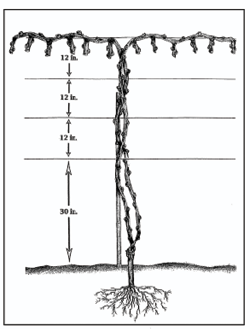
VSP — Cane Pruning (Year A)
• Every bud left on last year’s wood should produce a fruitful shoot.
• When we count the number of buds to leave on the vine at pruning, we are establishing the
number of potential fruiting shoots.Vertical Shoot Positioning (VSP)
Ilustration By Danielle Huber – Double A Vineyards, Marketing Specialist
